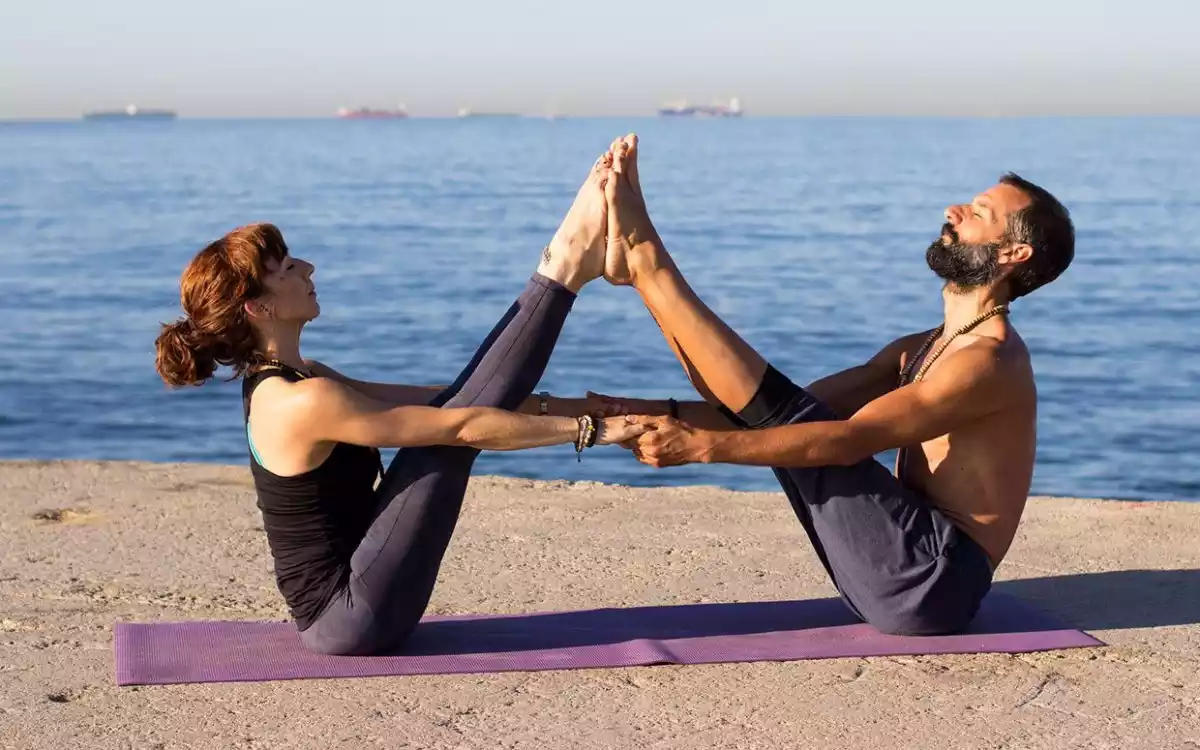Unlock the Secrets of Partner Yoga: 9 Poses to Strengthen Your Bond and Flexibility | Yoga Poses for 2 Person
9 best yoga poses for beginners : Yoga is a time-honored practice that harmonizes the mind, body, and spirit through physical postures, breath control, and meditation. While traditionally an individual pursuit, yoga can also be a shared experience, fostering deeper connections between partners. Partner yoga, or yoga for two people, involves two individuals performing poses together, enhancing trust, communication, and mutual support. This collaborative practice not only deepens the physical aspects of yoga but also strengthens the emotional bonds between participants.
In this comprehensive guide, we will explore ten yoga poses designed for two people. Each pose will be detailed with step-by-step instructions, benefits, and tips to ensure a safe and enjoyable practice. Whether you’re practicing with a friend, partner, or family member, these poses will help you build trust, improve communication, and deepen your yoga practice together.
Benefits of Partner Yoga
Engaging in partner yoga offers numerous physical, emotional, and psychological benefits:
-
Enhanced Communication: Performing poses together requires clear and open communication, fostering a deeper understanding between partners.
-
Increased Trust: Relying on each other for balance and support builds mutual trust and confidence.
-
Improved Flexibility and Balance: Assisting each other in poses can help deepen stretches and improve overall balance.
-
Strengthened Emotional Connection: Sharing the experience of yoga can enhance emotional bonds and intimacy.
-
Stress Reduction: The combined practice of mindfulness and physical touch can lead to reduced stress and a sense of calm.
Getting Started with Partner Yoga
Before diving into the poses, consider the following tips to ensure a safe and enjoyable practice:
-
Choose the Right Partner: Select someone you feel comfortable with and who is open to communication and collaboration.
-
Communicate Openly: Discuss any physical limitations or concerns before starting.
-
Warm Up: Begin with gentle stretches to prepare your bodies for the poses.
-
Listen to Your Bodies: Pay attention to any discomfort or pain, and adjust as needed.
-
Maintain Eye Contact: This fosters connection and ensures synchronization during poses.
-
Have Fun: Approach the practice with a playful and open-minded attitude.
1. Seated Forward Bend and Backbend (Paschimottanasana and Purvottanasana)
This pose combines a forward bend and a backbend, allowing partners to stretch the posterior and anterior chains of the body simultaneously.
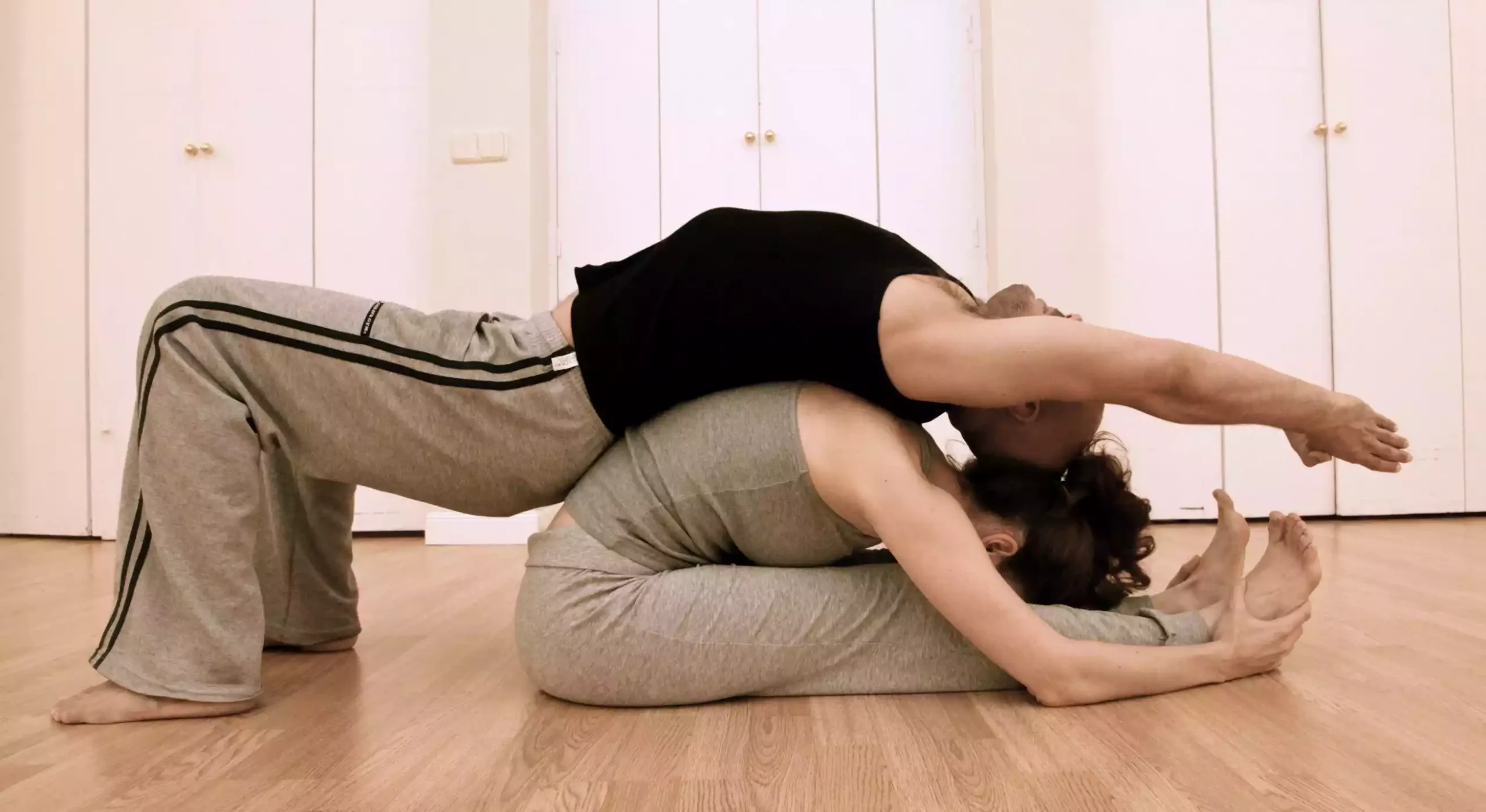
How to Perform:
-
Starting Position: Sit facing each other with legs extended, toes touching.
-
Grasp Hands: Hold each other’s forearms or hands firmly.
-
Coordinate Movement: One partner inhales and gently leans back, pulling the other into a forward bend.
-
Deepen the Stretch: Hold for a few breaths, ensuring both partners feel a comfortable stretch.
-
Switch Roles: The partner in the forward bend now inhales and leans back, pulling the other into a forward bend.
-
Repeat: Perform the sequence several times, synchronizing breath and movement.
Benefits:
-
Stretches the Hamstrings and Spine: Enhances flexibility in the back and legs.
-
Opens the Chest and Shoulders: Improves posture and counteracts the effects of prolonged sitting.
-
Promotes Synchronization: Encourages partners to move and breathe together harmoniously.
Tips:
-
Communicate: Ensure both partners are comfortable with the depth of the stretch.
-
Maintain a Straight Spine: Avoid rounding the back during the forward bend.
-
Use a Strap if Needed: If reaching hands is challenging, use a yoga strap or towel for assistance.
2. Double Downward Dog (Adho Mukha Svanasana)
This pose builds strength and flexibility while fostering trust and communication between partners.
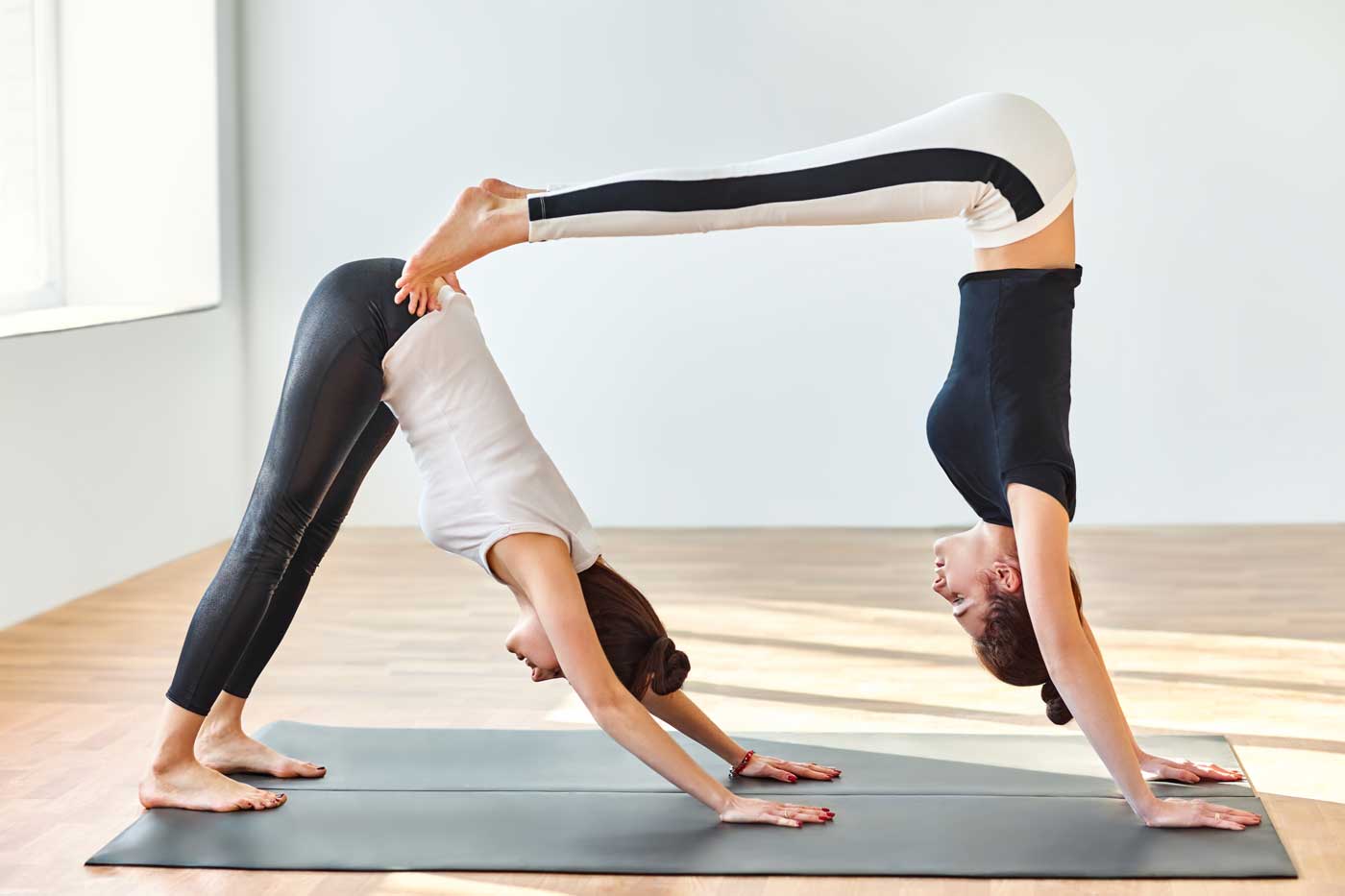
How to Perform:
-
First Partner’s Position: Partner A begins in a standard Downward Dog position.
-
Second Partner’s Position: Partner B stands facing away from Partner A’s back.
-
Foot Placement: Partner B steps backward, placing their feet on Partner A’s lower back or sacrum, ensuring even weight distribution.
-
Hand Placement: Partner B then places their hands on the ground, aligning their body into an inverted ‘V’ shape, mirroring Partner A.
-
Hold the Pose: Both partners maintain the position for several breaths, feeling the stretch and balance.
-
Release: Partner B carefully steps down, and both partners return to a neutral position.
Benefits:
-
Enhances Upper Body Strength: Engages shoulders, arms, and core muscles.
-
Improves Balance and Coordination: Requires partners to work together to maintain stability.
-
Deepens Trust: Partners rely on each other for support and balance.
Tips:
-
Communicate Clearly: Discuss comfort levels and make adjustments as needed.
-
Engage Core Muscles: This helps maintain stability and protects the lower back.
-
Use a Wall for Support: Beginners can perform the pose near a wall for added security.
3. Partner Boat Pose (Navasana)
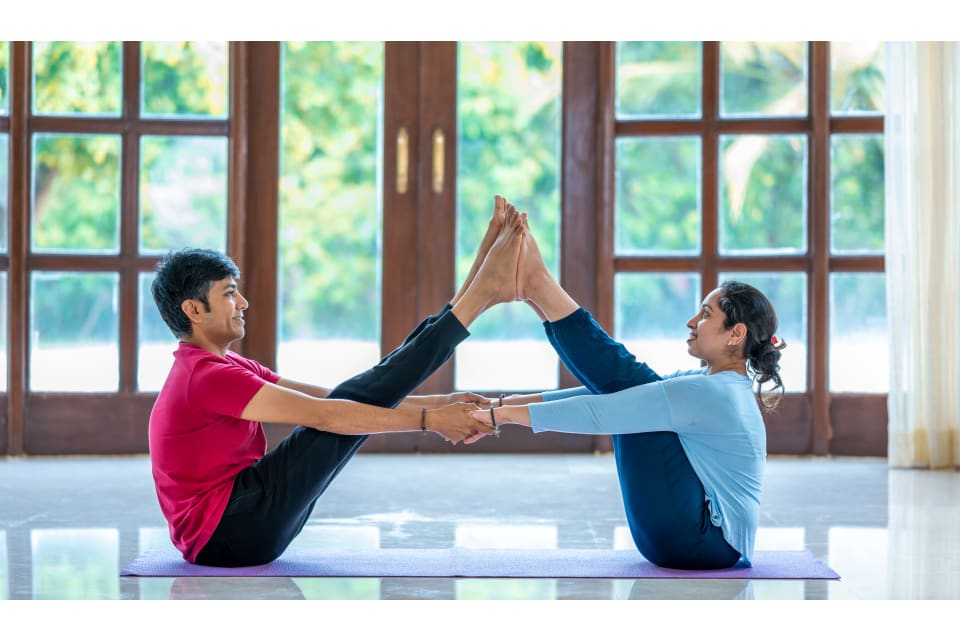
The Partner Boat Pose is an excellent way to strengthen core muscles while fostering balance and coordination between partners.
How to Perform:
-
Seated Position: Both partners sit facing each other with knees bent and toes touching.
-
Hold Hands: Reach out and grasp each other’s hands or wrists firmly.
-
Lift Legs: Together, lift your feet off the ground, bringing the soles of your feet to touch each other’s, creating a “boat” shape with your legs.
-
Extend Legs: Slowly straighten your legs upward, ensuring both partners maintain balance and keep their spines straight.
-
Engage Core: Hold the position for several breaths, engaging the core muscles to maintain stability.
-
Release: Bend the knees and gently lower the feet back to the ground.
Benefits:
-
Strengthens Core Muscles: Enhances abdominal strength and stability.
-
Improves Balance: Encourages coordination and mutual support.
-
Enhances Communication: Requires partners to synchronize movements and maintain eye contact.
Tips:
-
Maintain a Straight Spine: Avoid rounding the back to prevent strain.
-
Communicate: Discuss any discomfort and adjust as needed to ensure both partners are comfortable.
-
Use a Strap if Necessary: If flexibility is limited, use a yoga strap around each other’s feet for support.
4. Double Tree Pose (Vrksasana)
The Double Tree Pose enhances balance and concentration while fostering a sense of unity between partners.
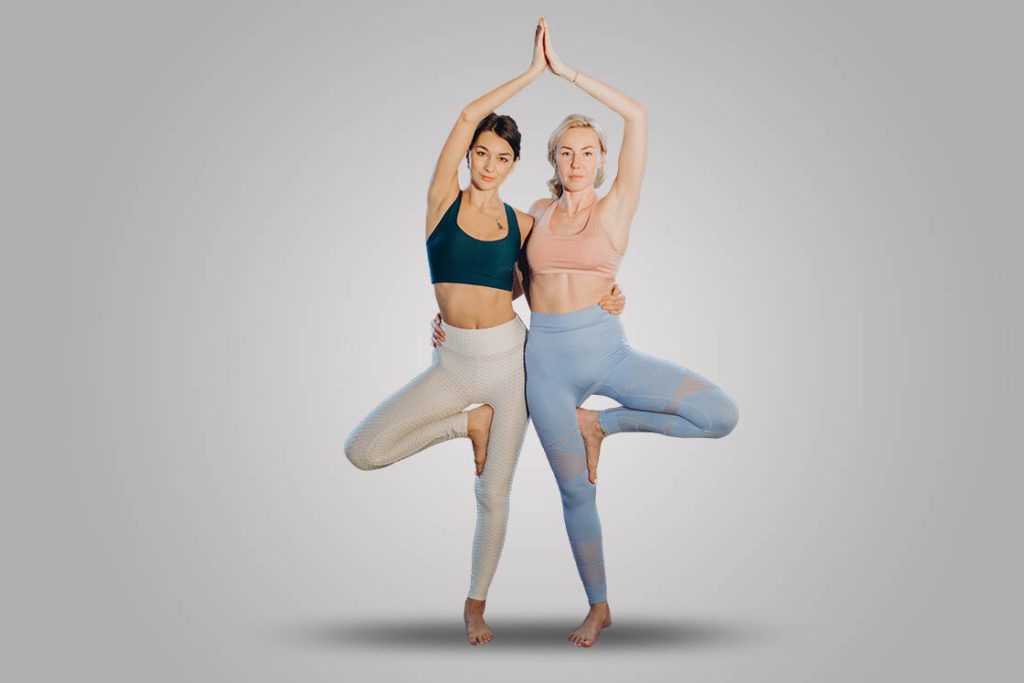
How to Perform:
-
Stand Side by Side: Partners stand next to each other, hips touching.
-
Inner Arms Around Each Other: Place your inner arms around each other’s waists for support.
-
Lift Outer Leg: Each partner lifts their outer leg, bending the knee and placing the sole of the foot against the inner thigh or calf of the standing leg.
-
Find Balance: Press into each other’s hips and engage core muscles to maintain balance.
-
Raise Outer Arm: Extend your outer arm upward, reaching toward the sky.
-
Hold the Pose: Maintain the position for several breaths, focusing on a fixed point to aid balance.
-
Release: Lower the lifted foot and arm, then switch sides to balance both legs.
Benefits:
-
Improves Balance and Stability: Enhances proprioception and coordination.
-
Strengthens Leg Muscles: Engages the muscles of the standing leg.
-
Encourages Unity: Promotes a sense of togetherness and mutual support.
Tips:
-
Focus on a Drishti (Gaze Point): Fixing your gaze on a stationary point can help maintain balance.
-
Communicate: Ensure both partners feel stable and make adjustments as needed.
-
Use a Wall for Support: If balance is challenging, practice near a wall for added security.
5. Partner Seated Forward Bend (Paschimottanasana)
This pose allows partners to deepen their forward bends with mutual assistance, enhancing flexibility and trust.

How to Perform:
-
Seated Position: Sit facing each other with legs extended, feet touching.
-
Hold Hands: Reach forward and grasp each other’s hands or wrists.
-
Inhale and Lengthen: Both partners inhale, lengthening through the spine.
-
Exhale and Lean Back: One partner exhales and gently leans back, pulling the other partner into a forward bend.
-
Hold the Stretch: Maintain the position for several breaths, ensuring a comfortable stretch.
-
Switch Roles: Gently return to the upright position and repeat, with the other partner leaning back.
Benefits:
-
Enhances Flexibility: Deepens the stretch in the hamstrings and lower back.
-
Builds Trust: Partners rely on each other to achieve a deeper stretch safely.
-
Encourages Communication: Requires verbal cues to ensure comfort and safety.
Tips:
-
Move Slowly: Avoid sudden movements to prevent strain.
-
Communicate: Check in with your partner to ensure the stretch is comfortable.
-
Use Props if Needed: If flexibility is limited, use a strap or towel to bridge the gap between hands.
6. Partner Camel Pose (Ustrasana)
The Partner Camel Pose is a heart-opening backbend that enhances flexibility and fosters emotional connection between partners.
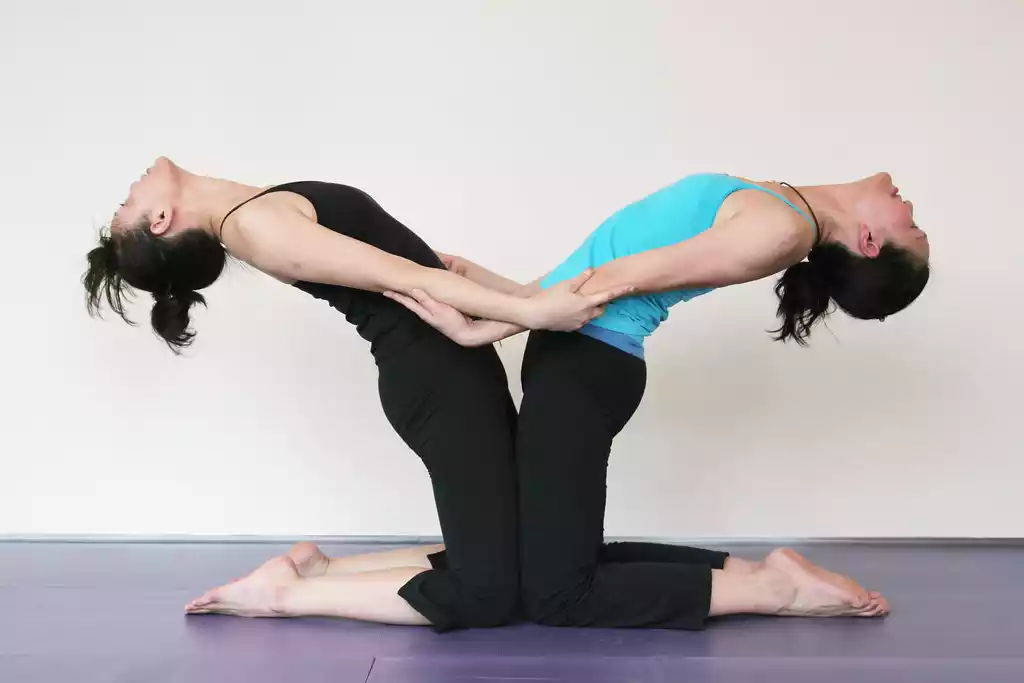
How to Perform:
-
Kneeling Position: Both partners kneel on the mat, facing each other with knees hip-width apart.
-
Hold Hands: Reach out and grasp each other’s forearms or hands for support.
-
Engage Core: Activate core muscles to support the spine and maintain balance.
-
Lean Back Together: Simultaneously, both partners gently lean back, allowing the chest to open and the spine to arch.
-
Support Each Other: Use the connection of your arms to support and deepen the stretch, ensuring both partners are comfortable.
-
Hold the Pose: Maintain the position for several breaths, focusing on heart opening and mutual support.
-
Return to Center: Slowly engage the core and return to an upright kneeling position together.
Benefits:
-
Opens the Chest: Stretches the chest and shoulders, counteracting poor posture.
-
Enhances Spinal Flexibility: Promotes a healthy and flexible spine.
-
Fosters Emotional Connection: Encourages vulnerability and trust between partners.
Tips:
-
Warm Up First: Perform gentle backbends and stretches before attempting this pose.
-
Communicate Boundaries: Ensure both partners are comfortable with the depth of the backbend.
-
Use Props if Needed: Place a cushion or block between the heels for added support.
7. Partner Savasana (Corpse Pose)
Concluding your partner yoga session with Partner Savasana allows both individuals to relax and integrate the benefits of the practice together.
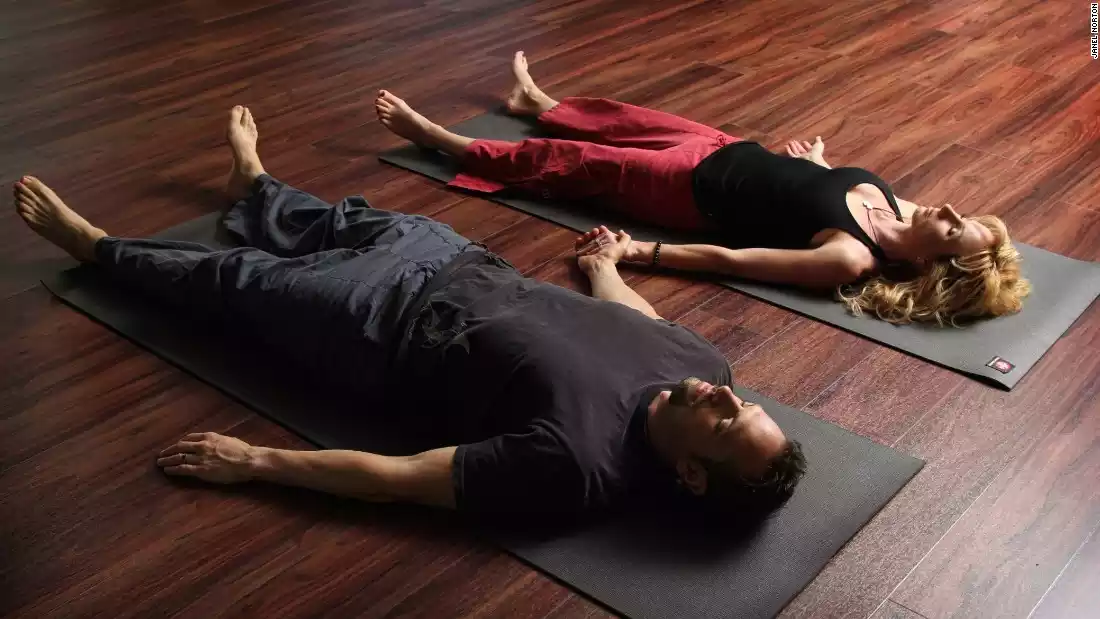
How to Perform:
-
Lie Down Together: Both partners lie on their backs side by side, with bodies close but not touching.
-
Find a Comfortable Position: Allow arms and legs to relax naturally, palms facing up.
-
Close Eyes and Breathe: Close your eyes and take deep, mindful breaths, focusing on relaxation.
-
Optional Connection: Gently touch hands or place a hand on each other’s heart to enhance the sense of connection.
-
Relax Fully: Stay in the pose for several minutes, allowing the body and mind to rest and rejuvenate.
-
Awaken Together: Gently wiggle fingers and toes, stretch, and slowly sit up together when ready.
Benefits:
-
Promotes Deep Relaxation: Calms the nervous system and reduces stress.
-
Enhances Emotional Bond: Sharing this restful space fosters a deeper connection.
-
Integrates Practice Benefits: Allows the body to absorb and integrate the effects of the yoga session.
Tips:
-
Create a Peaceful Environment: Dim the lights and play soft music to enhance relaxation.
-
Use Props for Comfort: Place a blanket under the head or knees if needed.
-
Respect Personal Space: Ensure both partners are comfortable with the level of physical closeness.
8. Partner Child’s Pose with Back Stretch (Balasana Variation)
This restorative pose combines the calming effect of Child’s Pose with a gentle backbend, fostering relaxation and trust.
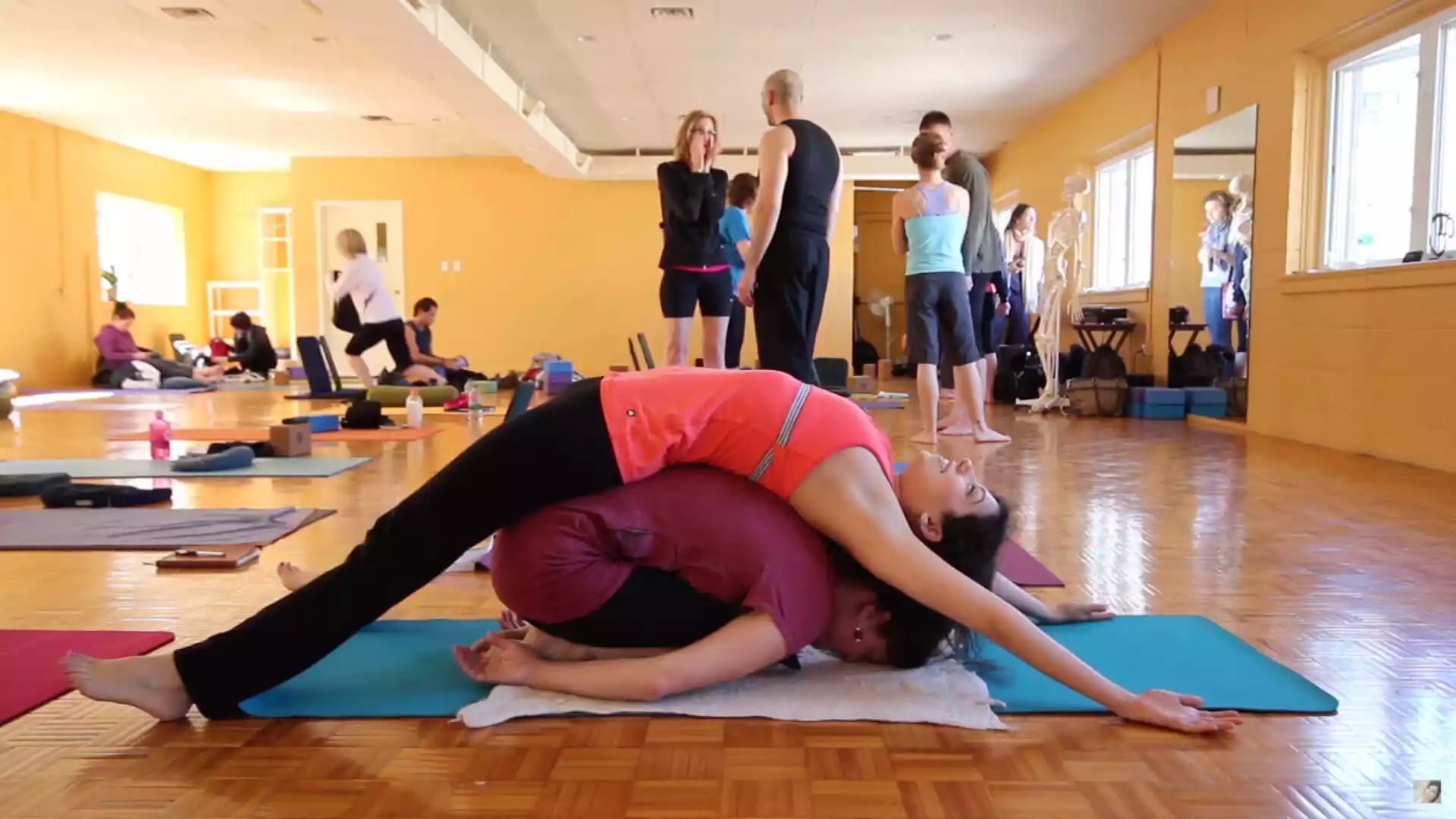
How to Perform:
-
First Partner’s Position: Partner A kneels on the mat, sitting back on their heels, and folds forward into Child’s Pose, extending arms forward.
-
Second Partner’s Position: Partner B stands behind Partner A, facing the same direction.
-
Align and Connect: Partner B places their hands on Partner A’s lower back or sacrum.
-
Gentle Pressure: Partner B applies gentle downward pressure, assisting Partner A in deepening the stretch.
-
Hold the Pose: Maintain for several breaths, ensuring open communication about comfort levels.
-
Switch Roles: Partners switch positions, allowing both to experience the stretch.
Benefits:
-
Promotes Relaxation: Calms the mind and reduces stress.
-
Stretches the Back: Elongates the spine and relieves tension.
-
Enhances Trust: Partners communicate and rely on each other for comfort and support.
Tips:
-
Communicate Openly: Partner A should inform Partner B if the pressure is too intense or needs adjustment.
-
Move Mindfully: Partner B should apply pressure slowly and mindfully.
-
Use Props if Needed: A bolster or pillow can be placed under Partner A’s chest for added support.
9. Partner Seated Spinal Twist (Ardha Matsyendrasana)
The Partner Seated Spinal Twist enhances spinal flexibility and encourages mutual support.
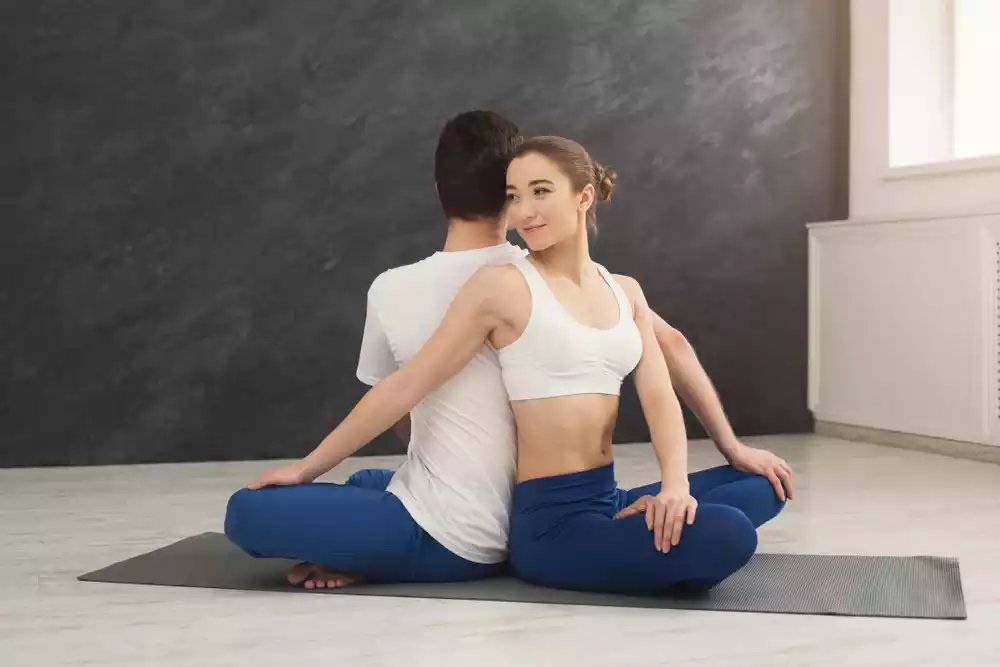
How to Perform:
-
Starting Position: Sit back-to-back with your partner, legs crossed comfortably.
-
Inhale and Lengthen: Both partners sit up tall, elongating the spine.
-
Exhale into Twist: Each partner turns to their right, placing their right hand on their partner’s left knee and their left hand on their own right knee.
-
Deepen the Twist: Gently pull on your partner’s knee to deepen the twist, ensuring both partners are comfortable.
-
Hold the Pose: Maintain the twist for several breaths, feeling the stretch along the spine and torso.
-
Release and Switch Sides: Slowly return to center and repeat on the opposite side.
Benefits:
-
Improves Spinal Mobility: Enhances flexibility and alignment of the spine.
-
Aids Digestion: Twisting motions can stimulate digestive organs.
-
Encourages Mutual Support: Partners rely on each other to deepen the stretch safely.
Tips:
-
Move Slowly: Avoid forcing the twist; gently deepen as flexibility allows.
-
Keep Shoulders Relaxed: Ensure shoulders are down and away from the ears.
-
Breathe Deeply: Use each exhale to relax further into the twist.
Incorporating these partner yoga poses into your routine can deepen your connection, enhance mutual trust, and promote physical and emotional well-being. Remember to communicate openly, move mindfully, and honor each other’s boundaries throughout the practice.
(Read the latest news of the country and the world first on TalkAaj (Talk Today News), follow us on Facebook, Twitter, Instagram and YouTube)
